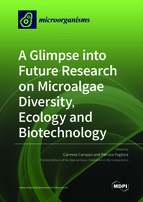A Glimpse into Future Research on Microalgae Diversity, Ecology and Biotechnology
A special issue of Microorganisms (ISSN 2076-2607). This special issue belongs to the section "Environmental Microbiology".
Deadline for manuscript submissions: closed (31 July 2022) | Viewed by 28923
Special Issue Editors
Interests: biodiversity of phytoplankton in coastal and brackish environments; ecology of harmful phytoplankton species; biogeochemical cycles and eutrophication: aquaculture and laboratory cultures
Interests: marine biology; Echinodermata; sea urchins; seastars; marine invertebrate immunity; xenobiotic immunotoxicity; bioactive molecules from marine organisms
Special Issue Information
Dear Colleagues,
Microalgae are an extremely important component of marine ecosystems’ functioning and climate regulation. Despite their significant contribution to productivity, microalgae diversity, mainly of prokaryotes, is still largely unknown. This may be partly due to the declining expertise in taxonomy (the basic science of biodiversity), which is also dangerously widening the gap between traditional and molecular approaches. Identifying microalgae species as well as the factors influencing a community structure and the interactions among organisms represents an important challenge to understand the functioning of an ecosystem.
Microalgae, using a network of signals, interact with all other organisms living in their environment. Signals are often transmitted by secondary metabolites that are generally not necessary for their daily functioning but play an important role in competition, defense, attraction. These molecules are recognized for having bioactive properties, but some of them are still largely underexplored and underexploited.
We look forward to receiving your contributions to this Special Issue in the form of original research or review papers that will improve our knowledge on microalgae diversity and ecology. Additionally, descriptions of the production of bioactive compounds including toxins, with their potential biotechnological applications, are also welcome.
Dr. Carmela Caroppo
Dr. Patrizia Pagliara
Guest Editors
Manuscript Submission Information
Manuscripts should be submitted online at www.mdpi.com by registering and logging in to this website. Once you are registered, click here to go to the submission form. Manuscripts can be submitted until the deadline. All submissions that pass pre-check are peer-reviewed. Accepted papers will be published continuously in the journal (as soon as accepted) and will be listed together on the special issue website. Research articles, review articles as well as short communications are invited. For planned papers, a title and short abstract (about 100 words) can be sent to the Editorial Office for announcement on this website.
Submitted manuscripts should not have been published previously, nor be under consideration for publication elsewhere (except conference proceedings papers). All manuscripts are thoroughly refereed through a single-blind peer-review process. A guide for authors and other relevant information for submission of manuscripts is available on the Instructions for Authors page. Microorganisms is an international peer-reviewed open access monthly journal published by MDPI.
Please visit the Instructions for Authors page before submitting a manuscript. The Article Processing Charge (APC) for publication in this open access journal is 2700 CHF (Swiss Francs). Submitted papers should be well formatted and use good English. Authors may use MDPI's English editing service prior to publication or during author revisions.
Keywords
- Microalgae
- Phytoplankton
- Cyanobacteria
- Harmful algal blooms
- Eutrophication
- Bioactive compounds
- Biotechnology
- Water quality
- Blue growth








